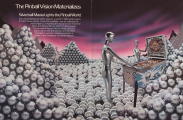
Random Thoughts & Pictures
Silverball Mania is a game I've had an eye on for several years. It's one of my favorite theme and art packages; naked chrome people playing pinball! There aren't a whole lot of pinball machines that feature pinball itself as the theme.

Backglass detail. Naked chrome people!

Backglass detail. He's really enjoying his game.

Backglass detail. Game lineup including a depiction of Bally's 1975 "Wizard!".

Backglass detail. A closer look at the Wizard! game reveals the names of designer Jim Patla and artist Kevin O'Connor. I like when designer and artist names appear in the art. But it seems odd that they would choose to place their names within a depiction of what was originally a Christensen glass.

Backglass detail. On each side of the glass is a woman holding up a silver ball. The reflection in the ball is artist Kevin O'Connor
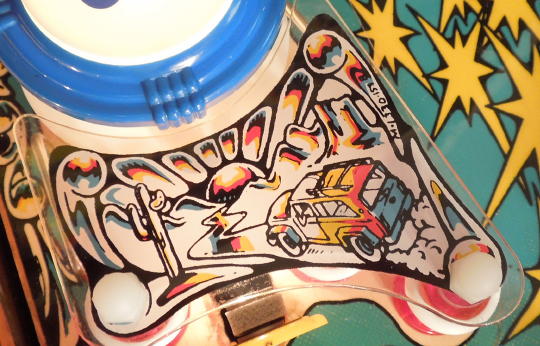
Kevin O'Connor included a scene of his Jeep on the plastic by the "V" target.
The game's signature playfield feature is the disappearing kicker located between the outhole and flippers. Light the kicker and you get a second chance with a ball that would otherwise be lost. The game also has a split outlane arrangement. The lower outlanes lead to the drain, but the upper outlanes lead to the disappearing kicker. Thanks to a strategically placed nail along each siderail, it's pretty easy to nudge balls into the upper outlanes and back to the kicker. The flippers are a little higher up on the playfield to accommodate the kicker and extra outlanes. I believe Silverball Mania was the first game to implement the disappearing kicker feature. The kicker was subsequently reused on Bally's widebody Hotdoggin'. But Hotdoggin' has the kicker off to the side of the playfield and it does not appear to be a significant aspect of play.
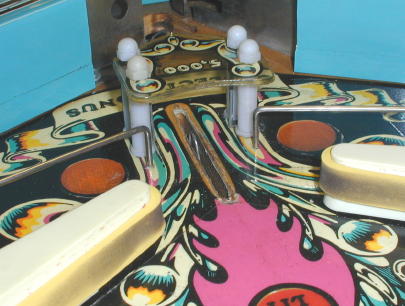
Disappearing kicker unlit and down.
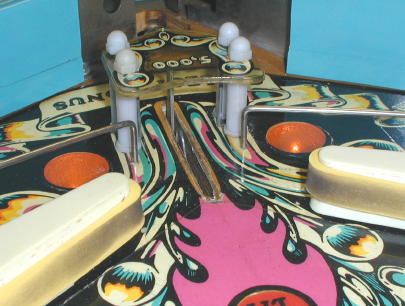
Disappearing kicker lit and up.
Shown below is the right siderail nail used to nudge the ball into the upper outlane. Note that there's another playfield dimple about a ¼" down from the existing nail position. Moving the nail down would make the game more difficult. Playfield nails or "pins" are what gave "pinball" its name. But the nails quickly fell out of favor in the post-war pinball era. So it's pretty neat to play a game from the 1980s where a simple nail, the origin of pinball, is a significant aspect game strategy.
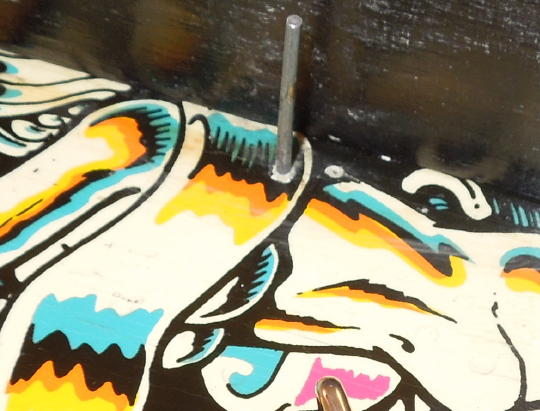
The right siderail nail.
The disappearing kicker comprises a solenoid, kicker arm and linkage all mounted on a bracket. The whole assembly moves up and down on a pair on vertical guide shafts. A second solenoid lifts the kicker assembly into its raised position. Note the notch on the back of the kicker arm (red circle). When the lift solenoid raises the kicker assembly, the notch latches into a plate on the underside of the playfield. When the kicker solenoid fires the ball is propelled back into play while the kicker assembly is simultaneously unlatched and falls back down by gravity. I have some additional detail pictures of this unit on my Silverball Mania repair page.

Under playfield view of disappearing kicker. The kicker arm and kicker solenoid are on the left. The lift solenoid is on the right. Note the latching notch on the back of the kicker arm (red circle).
Silverball Mania's upper playfield has an arrangement of three rollover lanes separated by four passive bumpers. The bumpers toggle the lit rollovers so the challenge is to nudge the ball toward the rollover you want while keeping it lit. In the context of a game from 1980, this passive bumper layout has an appealing retro feel to it. It's a change of pace for me. This is my sixth Bally game, but only my first to have something other than a kickout saucer up top.
Silverball Mania has a carry-over feature as indicated by the SILVERBALL letters in the lower left corner of the backglass. One SILVERBALL backglass letter is lit each time a SILVERBALL MANIA special is awarded. The feature is carried from game to game. The player who completes the SILVERBALL backglass letters earns a triple-credit special!
The number of lit letters can be manipulated by the operator via a push button under the playfield which is accessible by opening the coin door. A generous operator might push the button a few time to lite more letters thereby enticing more players to try for the triple-credit carry-over special.

The carry-over status is indicated by the SILVERBALL letters in the lower left corner of the backglass.

The under playfield push button for manipulating the SILVERBALL letters.
I bought my Silverball Mania at the 2011 White Rose Gameroom Show in York, Pennsylvania. The 2011 show was held on Friday October 7th and Saturday October 8th.

This Silverball Mania set up in the free play area would be mine by show's end.

I brought my Dolly Parton along for free play so I had two games to pack up and take home.
The key selling point for me was factory Mylar on the playfield. Silverball Manias without Mylar are usually toast. In fact, there were three Silverball Manias for sale at York that year. The other two did not have Mylar and were beyond consideration. So my playfield looks pretty good with only minor wear in the non-Mylared areas.
The backglass is almost excellent except for flaking along the lower edge. Portions of "SILVERBALL" and "Game Over" are missing. The affected area has been sealed. But I've already ordered a replacement repro glass from Classic Playfield Reproductions. The plastics are also in great shape. But again I have a reproduction set to install. The cabinet is solid, but unrestored with usual wear.
The lamp driver and sound boards are original with matching serial numbers. The MPU board appears to be original to Silverball Mania, but with a non-matching serial number. There is still a functional battery on the MPU board. There's no apparent damage, but the battery will be leaving shortly. The solenoid driver board looks to be from a Rolling Stones. The game has some sort of modern replacement rectifier board that doesn't quite fit in the original location. There are some connector hacks that could stand to be cleaned up and rebuilt. Otherwise the electronics and wiring appear solid.

An MPU battery that hasn't barfed itself on the board.

New rectifier board that doesn't quite fit.
Okay, time for another credit button rant... I like to coin my games. Homebrew credit button hacks piss me off. Now I have another hole to plug. Moreover the backside of the coin door has been virtually gutted. The coin mechs and micro switches are gone along with most of the wiring, brackets and hardware. It's going to take some significant parts scrounging to put all this back together. If your game doesn't have a free play setting, just turn down the replay thresholds. Stop drilling friggin holes!

What's left of the coin door.

Credit button hack.
I owned this game for exactly three years before selling it at the 2014 White Rose Gameroom Show in York. Gameplay is this machine's weak point. The center hoop shot just gives too much away. Seems like it could have been much better with a little more programming. It's a great game to look at, but didn't hold my interest in the long run.
I'm always curious to hear where one of my games may have ended up. If you happen to own this specific Silverball Mania (ESM 8096) please shoot me an email.
The four page promotional flyer is shown below. Note that the flyer shows yellow caps on the top four bumpers. But production games have blue caps on all bumpers. There also looks to have been a promotional poster for this game. The poster depicts the same image as the flyer's two-page centerfold except the wordy game description at left is replaced by a blue Bally logo. There was also a full-page magazine ad which was a variation on the flyer's third panel depicting the chrome guy standing in front of the game.
Promotional flyer for Silverball Mania. Click for larger pictures.
In 2008 (before I owned the game) I bought a Silverball Mania reproduction plastics set from Classic Playfield Reproductions. The set included a custom key fob and some custom free play coin drop windows.
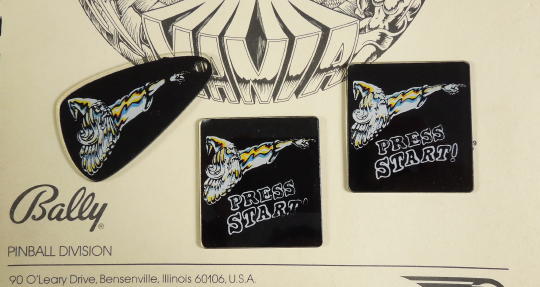
CPR promo plastics.
I bought an original Silverball Mania game manual and found the following notice stuffed inside. Click for larger image. Operators must have got the message because I rarely see games with the original metal mini post configuration. Most games I see have been modified with the plastic finned post configuration. But I have never seen an amber finned post as indicated in the notice. The posts are always red. Mine were red. I wasn't even aware that Bally produced an amber finned post. Interesting. Note that if you order a ring kit for this game you'll probably need to order an extra pair of rings for the finned posts if your game is so equipped.
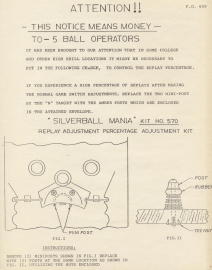
Notice Means Money. Click for larger image.
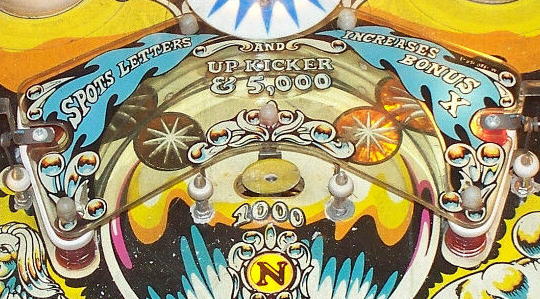
Here's another game showing the original mini posts around the "N" target.
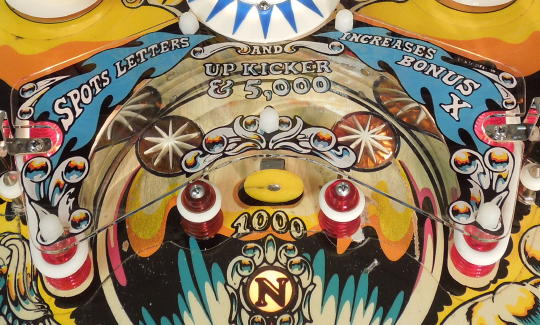
Here's my game showing the finned posts around the "N" target.
Silverball Mania was designed by Jim Patla. The upper-middle playfield layout was recycled on Patla's next game, Space Invaders.
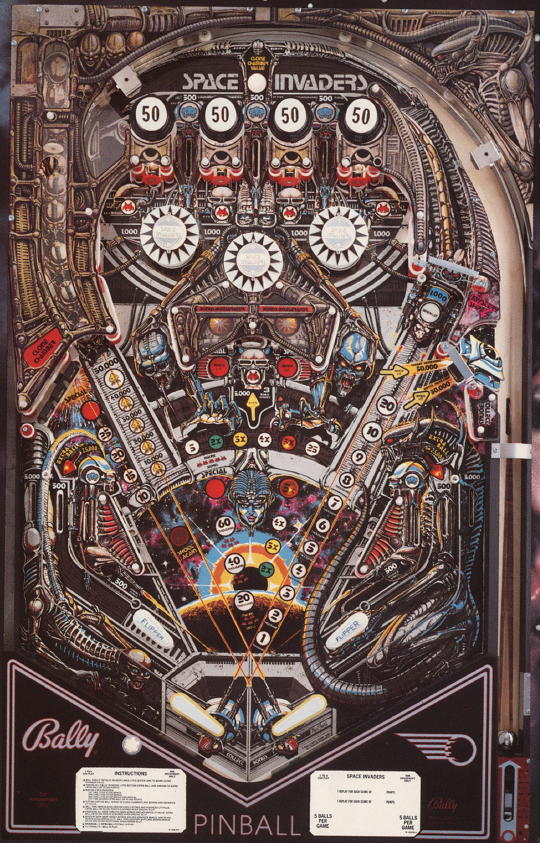
Space Invaders might be considered the widebody version of Silverball Mania.


